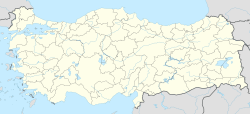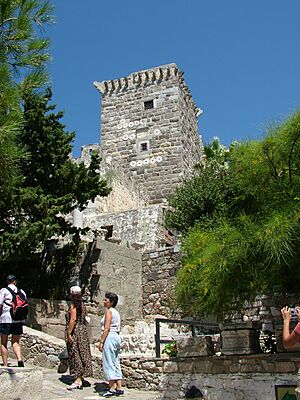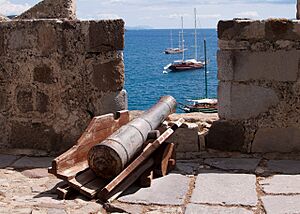Bodrum Castle facts for kids
Quick facts for kids Bodrum Castle |
|
|---|---|
| Muğla Province in Turkey | |
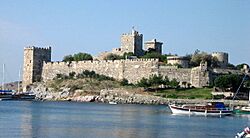
The castle from the south-east
|
|
| Coordinates | 37°1′54″N 27°25′46″E / 37.03167°N 27.42944°E |
Bodrum Castle (also called Bodrum Kalesi in Turkish) is an amazing old castle in Bodrum, a port city in southwest Turkey. It was built starting in 1402 by the Knights Hospitaller, also known as the Knights of St. John. They called it the Castle of St. Peter.
Many different countries helped build the castle. It has four main towers named after them: the English, French, German, and Italian towers. The castle's first chapel was built around 1407. Its main walls were finished by 1437.
Later, in 1523, the Ottoman Empire took control of the castle. The chapel was changed into a mosque, and a tall minaret was added. The castle stayed under Ottoman rule for nearly 400 years. After World War I, it was empty for a while. Then, in the early 1960s, it became the home of the Bodrum Museum of Underwater Archaeology. In 2016, UNESCO added it to Turkey's list of possible World Heritage Sites.
Contents
History of Bodrum Castle
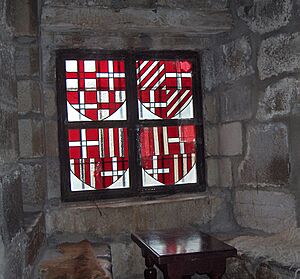
The Knights Hospitaller needed a strong base on the mainland. Their main headquarters were on the island of Rhodes. They chose a good spot across from the island of Kos, where they already had a castle. This location had been used for forts before. A very old fort from 1110 BC was there. A small Seljuk castle also stood there in the 11th century. This spot might even be where the palace of King Mausolos of Caria once stood.
Building the Castle
Construction of Bodrum Castle began in 1404. A German knight and architect named Heinrich Schlegelholt led the work. Workers were even promised a special reward in heaven for helping! They used strong green volcanic stone. They also used marble columns and carvings from the nearby Mausoleum of Halicarnassus. This famous tomb was one of the Seven Wonders of the Ancient World.
The first walls of the castle were finished in 1437. The chapel was one of the first buildings inside. It was rebuilt in a Gothic style around 1519-1520. Knights from Spain helped with this work. You can still see their names on some stones. The builders also dug 14 large cisterns. These collected rainwater for the castle.
Each group of Knights, called a "tongue," had its own tower. Each group was in charge of keeping a part of the castle safe. They also had to make sure enough knights and soldiers were there. The castle had seven gates leading to its inner parts.
The castle was designed to be very hard to attack. The paths to the gates twisted and turned. This made it difficult for attackers to find cover. They would face arrows, stones, or even hot objects. The knights put hundreds of painted coats of arms and carved designs on the walls. About 249 of these designs are still there today. They show the symbols of grand masters, countries, and individual knights.
The English Tower, which has three floors, was finished in 1413. One door opens to the inside of the castle. Another leads to the western wall. You could only get into this tower by a drawbridge. On the outside, there's an old carving of a lion. Because of this, it was also called "the Lion Tower." Above the lion, you can see the coat of arms of King Henry IV of England.
For over 100 years, St. Peter's Castle was a very important fortress for the Knights. It was a safe place for Christians in Asia Minor.
Attacks and Changes
The castle faced attacks as the Ottoman Empire grew stronger. Sultan Mehmed II attacked in 1453 and again in 1480. But the Knights of St. John fought them off. In 1482, Prince Cem Sultan, a son of Sultan Mehmed II, even found safety in the castle. He was trying to lead a revolt against his brother.
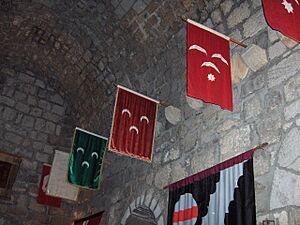
In 1494, the Knights decided to make the castle even stronger. They used more stones from the Mausoleum of Halicarnassus. The walls facing the land were made thicker. This was to protect against powerful cannons. The sea-facing walls were not as thick. The Knights had a strong navy, so they worried less about attacks from the sea. A Grand Master named Fabrizio del Carretto built a round tower to make the land side even stronger.
In the early 1500s, more sculptures from the Mausoleum were added to the castle for decoration. These included carvings of battles between Greeks and Amazons. There were also carvings of lions and a leopard.
When Suleiman the Magnificent planned an attack, the Grand Master, Philippe Villiers de L'Isle-Adam, ordered the castle to be strengthened again. Most of the remaining parts of the Mausoleum were broken up. Their stones were used to make the castle stronger. By 1522, almost all the Mausoleum's blocks were gone.
In June 1522, Sultan Suleiman attacked the Knights' main base in Rhodes. He had 200,000 soldiers. The castle of Rhodes fell in December 1522. As part of the surrender, the Knights had to give up their castles in Kos and Bodrum.
After the Ottomans took over, the castle's chapel became a mosque. A minaret was added. This mosque was called the Süleymaniye Camii. During World War I, a French warship fired on the castle. The minaret was destroyed in 1915. It was rebuilt to look like the original in 1997.
In 1846, Lord Canning, the British Ambassador, got permission to take 12 marble carvings from the castle. These showed battles between Greeks and Amazons. Later, in 1856, Sir Charles Newton took more stone lions and a leopard. These items are now in the British Museum.
Over the years, the castle was used for different things. It was a military base during a Greek revolt in 1824. In the 19th century, a hamam (public bath) was built inside. In 1895, the castle became a prison. After World War I, Italian soldiers used it for a short time. Then, it was empty for 40 years.
Bodrum Museum of Underwater Archaeology
In 1962, the Turkish government decided to turn Bodrum Castle into a museum. This museum would display amazing discoveries from ancient shipwrecks in the Aegean Sea. It became the Bodrum Museum of Underwater Archaeology. It has a huge collection of ancient glass, bronze, clay, and iron items. It is the biggest museum of its kind in the world.
Most of the museum's collection comes from underwater digs. These were done by the Institute of Nautical Archaeology (INA) after 1960. They explored many shipwrecks, including:
- Finike-Gelidonya shipwreck (12th century BC): This was the first underwater dig in Turkey.
- Bodrum-Yassiada shipwreck (Byzantine, 7th century AD): A Roman merchant ship with 900 large clay jars called amphoras.
- Serçe Limanı Shipwreck (glass, 11th century AD): A collection of Islamic glass items.
- Kaṣ-Uluburun shipwreck (14th century BC): This wreck held 10 tons of copper, 1 ton of tin, and 150 glass blocks. It also had pottery, Egyptian seals, and jewelry.
The old chapel in the castle now shows vases and amphoras from the Mycenaean Age (14th to 12th centuries BC). It also has items from the Bronze Age (around 2500 BC). The commercial amphoras show how these jars changed over time.
The Italian Tower has a collection of coins and jewelry from many centuries. Another room is dedicated to the tomb of a Carian princess. She lived between 360 and 325 BC. The museum's collection of ancient glass is one of the four largest in the world.
Two ancient shipwrecks have been rebuilt inside the museum. One is the Fatımi ship, which sank in 1077 AD. The other is the large Uluburun Shipwreck from the 14th century BC.
The castle also has a beautiful garden. It has almost every plant and tree found in the Mediterranean region. You can see peacocks walking under flowering trees. From the towers, you can see the whole city and nearby bays.
Images for kids
-
Collection of amphoras from different parts of the Mediterranean
See also
 In Spanish: Castillo de San Pedro de Halicarnaso para niños
In Spanish: Castillo de San Pedro de Halicarnaso para niños
- Halicarnassus
- Uluburun Shipwreck
- Order of Malta


